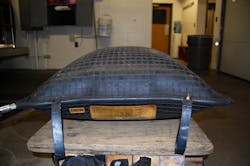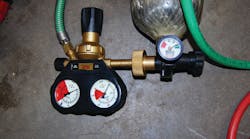Air bag lifting capacity is based on simple physics. The operating pressure of the bag, in pounds per square inch (PSI), is multiplied over the entire surface area of the bag to equal lifting force. This article aims to explain how to calculate the air bag’s actual lifting capacity. It is essential that members have a firm grasp of lifting capacities to ensure that they select the proper bags for the task at hand.
Bag Ratings/Power Curve
Each air bag has a maximum lift capacity, as well as a maximum lift height. The maximum lift capacity is listed on the bag in tons, and it is based on the surface area of the bag (see Photo 1). The system’s operating pressure is spread equally across the bag’s entire surface and creates lift force. The greater the surface area, the greater the lift force, which results in increased lift capacity.
Each air bag also has a maximum lift height. This is the height of the bag at maximum inflation. It is important to realize that the maximum lift capacity cannot be achieved at the maximum lift height. This is the concept known as the power curve. The power curve is the negative correlation between lift height and lift capacity. The lifting capacity of the air bag decreases as the lifting height increases. This is due to less surface area being in contact with the object being lifted. The air bag’s maximum lift capacity listed on the bag can only be achieved until the center of the bag is inflated approximately one-inch.
Lift Capacity Math
Each air bag has a theoretical lift capacity and an actual lift capacity. The theoretical capacity is what the bag should be capable of lifting if the entire dimensions of the bag are in contact with a solid surface below and with the object to be lifted. The actual lift capacity is what the bag will be able to lift given the surface area of the bag that is actually in contact with the object being lifted. It is critical that members understand the difference between the two capacities, as the theoretical lift capacity can be significantly more than what the bag will actually lift.
Theoretical Lift Capacity Math Formula:
- Air Bag Length x Air Bag Width x Operating Pressure in PSI = Theoretical Lift Capacity in Pounds
Theoretical Lift Capacity Math – Example 1:
- Utilizing a 20-inch x 20-inch bag operating at 116 PSI
- 20-inch x 20-inch x 116 PSI = 46,400 pounds (23.2 tons)
Each air bag has approximately ¼-inch to ¾-inch of seams on all sides, depending on the bag size and the manufacturer. These seams reduce the actual working surface of the air bag by ½-inch to 1½-inch from the start. Therefore, a 20-inch x 20-inch bag may have an actual working surface area of 19 inches x 19 inches.
Modified Theoretical Lift Capacity Math – Example 1:
- Utilizing the same 20-inch x 20-inch bag operating at 116 PSI
- Realizing that the bag has an actual working surface of 19 inches x 19 inches
- 19 inches x 19 inches x 116 PSI = 41,876 pounds (20.94 tons)
- This is the capacity that is normally listed on the air bag
The next factor that we need to take into account is the surface area of the bag that is in contact with the object being lifted. The air bag takes on a pillow shape as it is inflated, which reduces the surface area in contact with the object (Photo 2). Members need to calculate the surface area that is in contact with the object in order to get the actual lift capacity of the bag.
Actual Lift Capacity Math Formulas:
- Actual Length x Actual Width x Percent of Bag in Contact with Object x Operation Pressure in PSI = Actual Lift Capacity in Pounds
Actual Lift Capacity Math – Example 1:
- Utilizing the same 20-inch by 20-inch bag operating at 116 PSI
- Realizing the actual working area of the bag is 19 inches x 19 inches
- With 75% of the bag in contact with the object being lifted
- 19 inches x 19 inches x .75 x 116 PSI = 31,407 pounds (15.7 tons)
Actual Lift Capacity Math – Example 2:
- Same scenario as Example 1, but with only 25% of the bag in contact with the object being lifted
- 19 inches x 19 inches x .25 x 116 PSI = 10,469 pounds (5.23 tons)
Notice the significant difference of 20,938 pounds between the modified theoretical lift capacity (31,407 pounds) and the actual lift capacity (10,469 pounds) when only 25% of the bag is making contact. Members need to recognize the pillowing of the air bag and realize the considerable difference between the stamped-rated capacity on the bag and what the air bag is actually capable of lifting.
Stacked Bags vs. Side-by-Side Bags
Under normal operating conditions two air bags, one smaller than the other, will be stacked on top of one another (Photo 3). This is done to ensure there will be enough lift height to achieve the objective. When two bags are stacked, the maximum lift capacity is that of the smaller bag. The capacities of the air bags are not added together. Therefore, if a 10-ton bag is placed on top of a 20-ton bag, the maximum theoretical capacity of the system is 10 tons. Of course the actual lift capacity of the system depends on the surface area in contact with the object to be lifted.
The only time the capacities of the two bags are added together is when they are placed side-by-side and inflated simultaneously. The bags being placed side-by-side increase the surface area in contact with the object to be lifted. Much more on bag placement will be covered in future articles.
Conclusion
It is necessary that members understand the load capacities of the air bag system. It is critical to be aware of the difference between the theoretical and actual lifting capacities to ensure that system failure does not occur. Quickly determining which air bags to use is essential for ensuring a safe and effective rescue operation.
For the full series of Air Bag Operations







